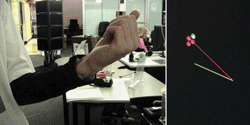Researchers at the Massachusetts Institute of Technology in Cambridge, MA, have developed a system to track motion efficiently that have significant ramifications for computer game play and educational video. The researchers say that it will provide a cheaper and more efficient way to track motion, especially for creating special effects for movies. Just imagine what this can do for kids learning a sport or perhaps learning to play a musical instrument.

Photosensors are embedded in the black fabric and blue vibrators surround the subject’s wrist.
The system uses a projector to send pulses of near infrared light approximately 10,000 different patterns a second. When the patterns hit the tiny photosensors embedded in the subject’s clothes, the photosensors capture the coded light and convert it into a binary signal that indicates the position of the sensor. Because the patterns of light will hit the sensors differently, depending on where they are, each sensor receives a unique light pattern.
These patterns are recorded about 500 times a second for each sensor. The sensors send the information to a thin, lightweight microcontroller worn by the subject under the clothes, which then transmits the data back to a computer via Bluetooth. The system can support millimeter-accurate location and bio-parameter tracking at thousands of points on the body. Such a fabric, called “second skin,” can compute and predict 3D representations of human activity and use them for a closed-loop control to augment human performance. The goal is to support a detailed analysis and control of higher-level human movement. The first phase of the project involves building next-generation optical communication tools.
Traditional tracking systems involve high-speed cameras placed around a specially lit set. The subject being tracked wears special markers that reflect light emitted by the cameras. The cameras capture and record the reflected light several times a second, to track the subject’s motion. When the system is used to make movies, software programs and a team of animators convert the data into an animated character.
This new device doesn’t rely on cameras at all. Instead, the system uses inexpensive projectors that can be mounted in ceilings or outdoors. Therefore, the system can be used indoors and out without special lighting, and it costs only a few thousand dollars. The whole system can cost less than $1,000, with each photosensor costing about $2, a vibrating sensor $80, and a projector $50. Watch second skin in action at http://www.technologyreview.com/video/?vid=327
For more information go to http://www.technologyreview.com/computing/22555/
Paul O’Shea
Advertisement
Learn more about Massachusetts Institute of Tec





